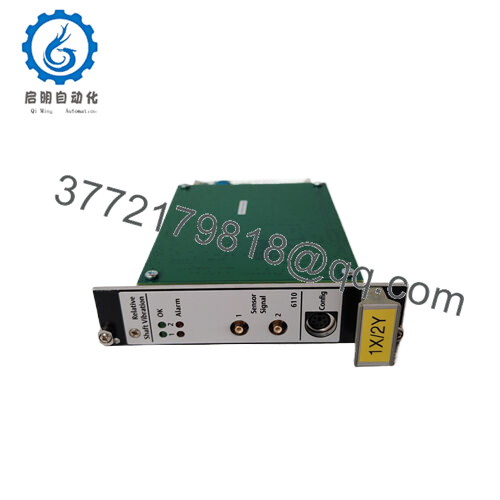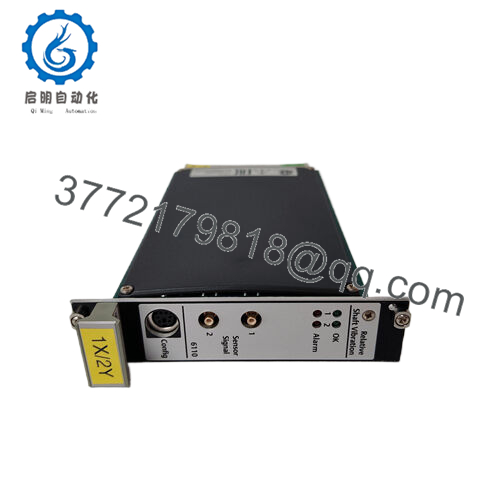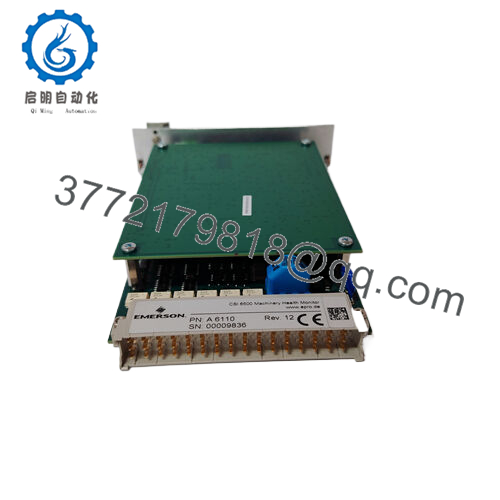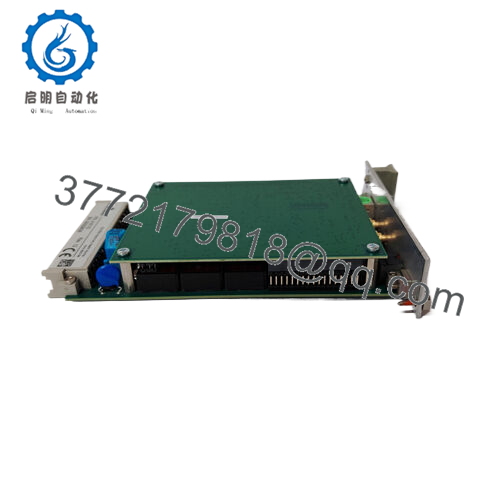Description
In the unforgiving dynamics of industrial automation, where rotating machinery like turbines and compressors must operate under relentless mechanical stresses without succumbing to imbalance or misalignment, the oversight of vibration anomalies can precipitate catastrophic breakdowns—yielding rotor rubs, bearing seizures, or shaft fractures that halt production and endanger personnel in milliseconds. Envision a gas turbine in a power generation facility, where subtle shaft displacements from thermal expansions go undetected amid high-speed revolutions, escalating into resonance events that compromise grid stability and invite API 670 violations, or a centrifugal pump in a refinery where relative motion between rotor and stator erodes seals, spiking maintenance calls and leakage risks under IEC 61508 SIL 2 mandates. These vulnerabilities are the undercurrents in process control landscapes, where high reliability hinges on proactive vibration surveillance to safeguard I/O signals from field accelerometers or proximity probes, yet legacy monitors often falter with limited channel density or noise susceptibility, obliging engineers to deploy multi-vendor patches or oversampled polling that inflate integration costs and false alarm fatigue. Without granular, real-time relative measurement, expansions into predictive regimes devolve into reactive firefighting, transforming asset guardians into afterthoughts.
This is the vigilance vacuum the Emerson A6110 addresses as a Shaft Relative Vibration Monitor within the AMS 6500 Machinery Health Management system, engineered to capture and analyze differential motions with forensic precision for the most mission-critical rotordynamics. In high-throughput settings like offshore compression trains or pulp mill refiners, it asserts itself during machinery upgrades, where escalating RPMs and load variances strain conventional probes; absent such a module, operators contend with aggregated vibration data that masks localized threats or triggers indiscriminate trips. The Emerson A6110 integrates seamlessly into a 1-slot rack alongside thrust or case expansion monitors, processing dual-channel eddy-current inputs to compute peak-to-peak displacements up to 2 mils, while its API 670-compliant alarms—gap, direct, and not-ok relays—enable tiered responses from warnings to shutdowns. This surpasses basic thresholding—it’s a rack-mount sentinel with hot-swappable firmware that buffers trends for AMS Suite diagnostics, ensuring I/O signal robustness amid electromagnetic interference.
- A6110
For reliability engineers weighing protection schemes, the Emerson A6110 distills essentials: it condenses rack footprints by supporting up to 10 monitors per chassis, configurable via AMS Device Manager for custom filters, and its -30°C to +65°C tolerance streamlines turbine hall installs. In rotordynamic realms where downtime eclipses $100K/hour, this monitor’s bandpass filtering (10 Hz to 10 kHz) preempts nuisance alerts, recasting vibration vectors into actionable intel. Whether embedding in a steam turbine’s overspeed loop or scaling a multistage compressor array, the Emerson A6110 fortifies your ecosystem with modular integration that elevates process control, blending acute acquisition with resilient alarming to endure mechanical maelstroms.
Positioned at the perceptive core of your AMS 6500 rack, the Emerson A6110 functions as the discerning decoder of shaft-stator interplay, sliding into a universal slot where it draws from redundant 24 VDC rails to amplify proximity probe signals through preamps, yielding relative displacement vectors for host integration. It interconnects via the system’s Modbus or OPC backbone, ingesting paired X-Y eddy currents from non-contact sensors to derive orbital plots and phase references, then dispatching buffered spectra downstream to the AMS server or DCS overlays like DeltaV. In the I/O architecture, it anchors upstream from field mounts—typically 5-80 mV/mil probes—and downstream of rack power, where processed envelopes (velocity, acceleration) feed logic solvers for de-energize-to-trip, fostering redundancy through dual-voting channels for SIL 2 fault tolerance.
Deployment unfolds with tactical insight: no bespoke cabling, as Bently Nevada-compatible connectors facilitate retrofits, while embedded DSP filters out 60 Hz harmonics for clean baselines, alerting via dry contacts on 50% gap deviations. For a compressor journal bearing, the Emerson A6110 discriminates direct vs. reverse rotations at 3600 RPM, archiving 1024-point FFTs for trend forensics; diagnostics flag probe faults via LED codes, cueing isolated swaps. This locus amplifies the stack’s acuity—dovetail with A6113 case monitors for holistic profiling, or federate with Ovation for turbine sequencing—while conformal shielding repels 95% RH in process steam. The Emerson A6110 thereby knits into your machinery mesh as a vigilant varlet, where motions manifest with measured grace, and spectra spotlight safeguards rather than specters.
| Specification | Details |
|---|---|
| Model Number | A6110 |
| Brand | Emerson |
| Type | Shaft Relative Vibration Monitor |
| Input Voltage | 18-36 VDC |
| Operating Temp Range | -30°C to +65°C |
| Mounting Style | Rackmount (1-slot) |
| Dimensions | 10.25 x 1.75 x 8 in (260 x 44 x 203 mm) |
| Weight | 2.5 lbs (1.13 kg) |
| Interface/Bus | Modbus RTU, OPC DA |
| Compliance | API 670, ISO 10816, CE, RoHS |
| Supported Protocols | Modbus RTU, HART (via AMS) |
| Typical Power Draw | 8 W |
Selecting the Emerson A6110 instills a reliability bedrock where dual-channel voting quells probe biases in unbalanced fields, permitting shafts to whirl within 0.5 mil envelopes amid thermal bows—your assets evade the escalation ladders that once amplified alerts, all while bandpass tuning sustains spectral clarity through gear mesh noise. In high-vibe enclosures, its isolated preamps repel coupling currents that skew readings, upholding I/O signal veracity so envelopes track truths across speed sweeps, calibrated to persist sans recalibration drifts.
The maintenance ethos tilts to prescience, as trend buffers and fault latches surface probe gaps via network pings, pinpointing a coil short in archives before alarm anarchy—trimming interventions from overhaul odysseys to targeted tweaks and easing engineering for orbit forecasts over fault frays. Engineered for the endurance of continuous revolutions, it avows abiding assurance via shock-quenched mounts that brave 5 g profiles, elevating MTBF beyond 100,000 hours while culling spares to probe kits. For maturing fleets, the Emerson A6110‘s rack-agnostic fit accelerates monitor migrations, eluding revalidation rigors, freeing cycles for AI-augmented anomaly hunts on vibration veins.
Broaden the lens, and its OPC conduit channels spectra to historian havens, correlating relative plots with lube metrics to blueprint bearing breaths preemptively. Custodians navigate with amplified assurance, as threshold transgressions surface as lucid beacons, abridging rally chains in whirl shadows. Championing the Emerson A6110 engenders a sentinel that surmises surges, amalgamating tenacious tally with tactical tenacity to exalt your industrial automation from reactive to resolute.
In aero-derivative gas turbines, the Emerson A6110 scrutinizes journal displacements amid thrust variances and fuel pulses, where misalignment menaces blades—its relative vectors secure critical system uptime, enveloping motions in process control environments to preempt rubs without power forfeits.
Hydro pump-storages embed it for thrust collar feedbacks, defying water hammer and silt scour; under these harsh conditions, the Emerson A6110‘s API 670 scaffolding delivers high reliability, voting channels for glitch-free startups in fast data cycles across reservoir ramps.
Within sugar centrifuge bowls, it aggregates rotor orbits from imbalance sensors, with RoHS resonance suiting effluent refits—channel precision enables lean racks, minimizing cabling in regulated process control environments. These vignettes exalt the Emerson A6110‘s mettle for rotordynamic stewards honing against harmonics.
A6111 – Thrust Position Monitor companion for axial load integration in multistage compressors
A6113 – Case Expansion Monitor variant for thermal growth pairing with A6110 relatives
A6500-10 – Base rack chassis housing the A6110 in full AMS 6500 protection suites
PR6426/010-140 – Epro proximity probe kit optimized for A6110 eddy-current inputs
3500/42M – Bently Nevada 4-channel alternative for legacy vibration stacks with A6110
A6112 – Velocity/Acceleration Monitor add-on for broadband vibration alongside A6110 shafts
AMS 6500-R1 – Rack interface module extending A6110 diagnostics to DeltaV overlays
PR9370/010-010 – Accelerometer companion for case-mounted inputs feeding A6110 trends
When staging the Emerson A6110 for your AMS 6500 rack, cross-check probe calibration—post-ISO 10816 ensures gap linearity, per Emerson’s alignment guide, so a bench multimeter flags variances upfront. Gauge slot ventilation; in >70% loaded chassis, stipulate 15 CFM fans to hold internals below 65°C, and validate DC rails for <50 mV ripple—pairing a regulated PSU nips startup surges. Inspect BNC connectors for shield continuity, as micro-frays can inject 60 Hz artifacts from install.
Post-rack, quarterly Modbus polls for envelope drifts exceeding 10% sync with front LEDs for channel harmony. Biannually, run self-proofs via AMS software—simulate a 1 mil orbit to clock alarm latency under 100 ms—and reseat ribbon cables to 0.5 Nm, vigilant for pin creep in vibe zones. For steam-laced perches, annual conformal audits via loupe catch breaches early, paired with spectrum dumps for baseline benchmarks. These cadences mesh into machinery PMs, perpetuating the Emerson A6110‘s perspicacity without commandeering calendars.





 WhatsApp: +86 16626708626
WhatsApp: +86 16626708626 Email:
Email:  Phone: +86 16626708626
Phone: +86 16626708626


